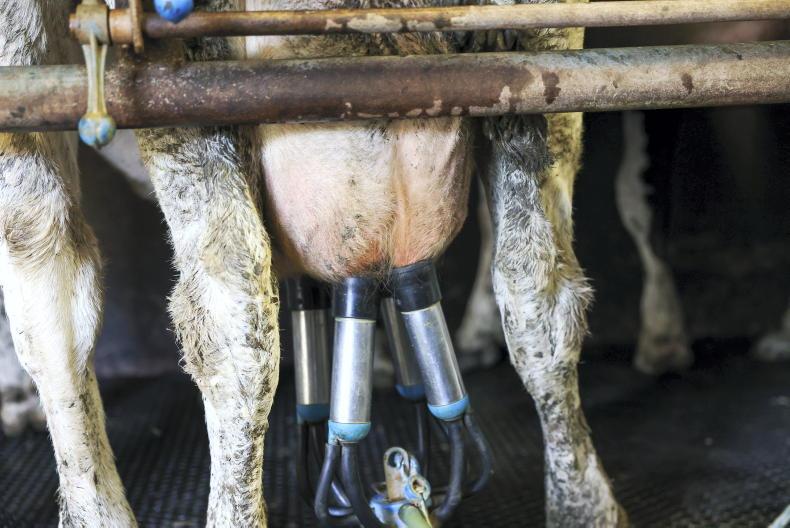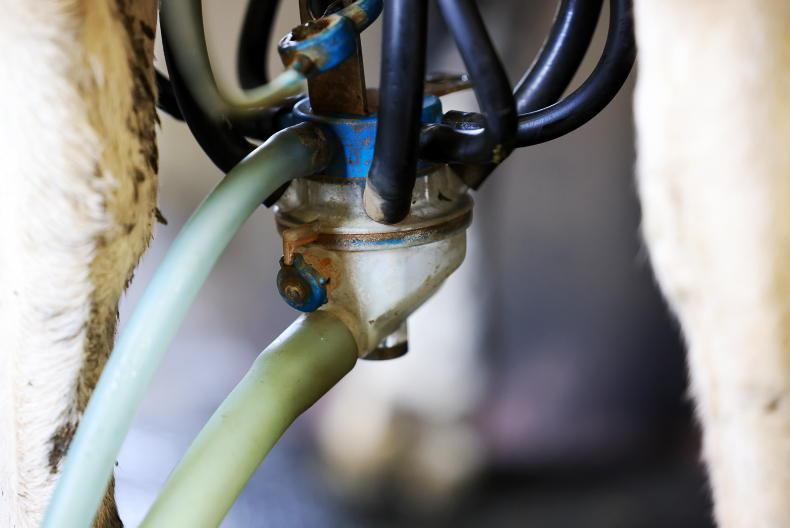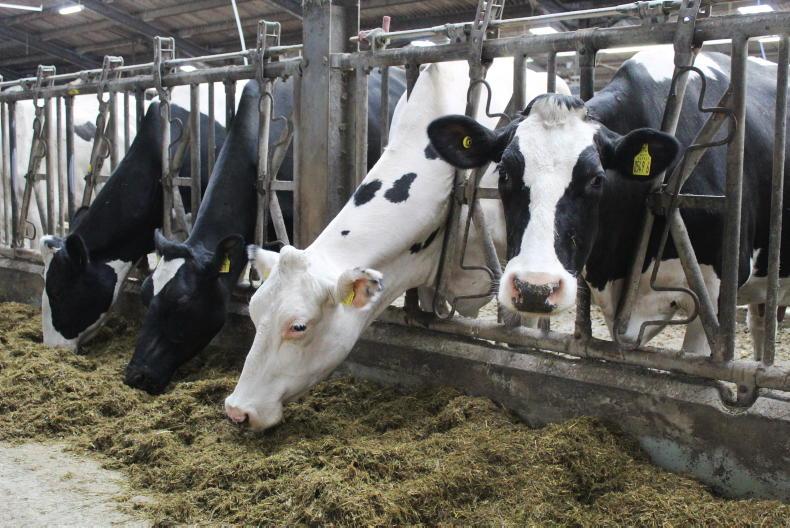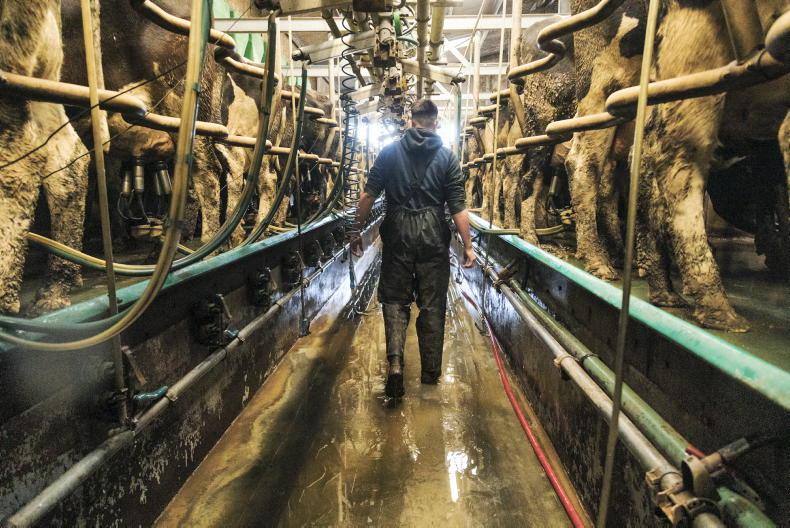Last Friday, Tirlán notified its suppliers that from 1 January 2025, all of its milk sourced in NI will be paid under an A+B-C system.
The move is the end point of a four year transition to a milk solids base payment system, which began in April 2021.
Back then, Tirlán (Glanbia Ireland) outlined that it would gradually increase the increment values on butterfat and protein each year.
At the same time, the base level for butterfat and protein would also increase annually. Where farmers consistently managed to raise the butterfat and protein content of their milk, they would generally be better off financially.
Options
In the lead up to 1 January 2025, Tirlán will operate a dual pricing structure in NI, with suppliers given two possible options.
Option one will pay under the existing pricing model, as originally communicated to suppliers in March 2021.
From April 2022 to March 2023, Tirlán will pay 0.024p/l for every 0.01% increase in butterfat above a base of 3.87%. Protein is worth 0.043p/l for each 0.01% increase above a base of 3.22%.
From April 2023, the value of butterfat increases to 0.027p/l, with protein rising to 0.049p/l, while from April 2024 to January 2025, butterfat rises to 0.03p/l from a base of 3.90% and protein to 0.054p/l from a base of 3.25%.
Hybrid model
Option two is a hybrid between the current pricing structure and an A+B-C payment. Under this option, 25% of a farmer’s milk supply from April to December 2022 is paid under A+B-C, with the remaining 75% under the existing model, as per option one.
From January 2023, the A+B-C percentage increases to 50%, then to 75% from January 2024. By January 2025, all Tirlán suppliers in NI will automatically move to a 100% A+B-C payment model.
What is A+B-C?
The A+B-C system is designed to reward farmers for producing milk with high solids, leading to efficiencies within dairy processing.
Under this model, processors issue a monthly payment for 1kg of protein (the A element) and a separate payment on 1kg of butterfat (the B element).
Protein tends to be worth more than butterfat. For September, Tirlán is paying €10.53 per kg of protein, including VAT, with butterfat valued at €5.265/kg.
The C element is a deduction per litre to reflect the cost of processing milk.
What is A+B-C worth to farmers?
To compare the value of milk between the two options, our analysis is based on a dairy farmer supplying 750,000l annually, with milk solids and supply profile matching the NI average.
Calculation
Under the A+B-C option, the example uses Tirlan’s monthly value for protein and butterfat, as paid to suppliers in the Republic of Ireland (ROI) since April 2022. Euro values are converted to sterling at €1 = 87p, with VAT also deducted.
For April, our example farmer supplied 69,797l of milk at 4.11% butterfat and 3.27% protein. Under option one, Tirlán’s base price for April was 41.65p/l.
Once payments have been made on butterfat, protein, hygiene and volume, monthly milk sales come to £30,181.
For option two, the monthly volume is multiplied by 1.03 to convert litres to kg of milk, which comes to 71,890kg.
At the outlined figure, our farmer produces 2,350kg of protein valued at £7.98/kg and 2,954kg of butterfat valued at £3.99.
The C element is a deduction of 4c/l or 3.5p/l. Based on 25% of monthly supply paid under the A+B-C model and the remaining 75% paid under the same model as option one, monthly milk sales come to £31,386, giving an additional £1,205 in income.
Higher payments
In May, the farmer supplies 73,565l at 4.01% butterfat and 3.28% protein, with 68,295l produced in June at 3.94% butterfat and 3.23% protein.
Again, at the prices that applied in May and June, the hybrid A+B-C, returns more money with approximately £1,245 extra milk sales each month.
The same trend exists in July and August, with the A+B-C option yielding an additional £1,198 and £1,174.
For September, the farmer supplies 52,902l at 4.10% butterfat and 3.36% protein.
Option one returns a milk cheque of £25,818 while option two gives milk sales of £26,940.
The analysis therefore suggests that based on prices Tirlán have paid out either side of the border this year, any NI farmers around or above the average for milk solids should opt for the A+B-C option.
Only those significantly below the NI average will be worse off under A+B-C.
Tirlán’s decision to pay 100% of its NI milk pool under an A+B-C model potentially sets a new direction for the NI dairy industry.
The clear incentive given to Tirlán farmers is to supply higher solids milk and those that do will be financially rewarded. At the same time, low solids producers will be worse off.
Ultimately, the evidence from the ROI is that farmers respond to these market signals. Since the A+B-C model was introduced in 2007, average butterfat has increased from 3.77% to 4.23%, while protein has moved from 3.32% to 3.55%. In 2021, fat and protein averages in NI stood at 4.10% and 3.30% respectively. However, over the years, there has been strong resistance to A+B-C pricing from NI processors, and from some farmers.
The main concern from processors is that it will lead to a shift towards spring-calving systems, as in ROI, upsetting our relatively flat milk production curve.
But it is highly questionable whether this will occur, given that many NI farmers are already operating efficient autumn and all-year round calving systems and do not have the land base, land type or infrastructure to move to spring calving.
The example of the Netherlands also highlights that it is possible to breed cows that combine high yield and high milk solids in relatively intensive production systems. In 2021, the Dutch dairy herd averaged 4.45% butterfat and 3.59% protein, on average yields of around 8,600l.
But perhaps the strongest argument for a switch towards milk solids payments is an environmental one.
Current NI pricing encourages farmers to produce milk volume, not solids, however, hauling water off farms and utilising energy to burn it off in processing, just does not stack up.
Read more
Glanbia Milk changing to milk solids payment in Northern Ireland
Lost signals around higher milk solids
Last Friday, Tirlán notified its suppliers that from 1 January 2025, all of its milk sourced in NI will be paid under an A+B-C system.
The move is the end point of a four year transition to a milk solids base payment system, which began in April 2021.
Back then, Tirlán (Glanbia Ireland) outlined that it would gradually increase the increment values on butterfat and protein each year.
At the same time, the base level for butterfat and protein would also increase annually. Where farmers consistently managed to raise the butterfat and protein content of their milk, they would generally be better off financially.
Options
In the lead up to 1 January 2025, Tirlán will operate a dual pricing structure in NI, with suppliers given two possible options.
Option one will pay under the existing pricing model, as originally communicated to suppliers in March 2021.
From April 2022 to March 2023, Tirlán will pay 0.024p/l for every 0.01% increase in butterfat above a base of 3.87%. Protein is worth 0.043p/l for each 0.01% increase above a base of 3.22%.
From April 2023, the value of butterfat increases to 0.027p/l, with protein rising to 0.049p/l, while from April 2024 to January 2025, butterfat rises to 0.03p/l from a base of 3.90% and protein to 0.054p/l from a base of 3.25%.
Hybrid model
Option two is a hybrid between the current pricing structure and an A+B-C payment. Under this option, 25% of a farmer’s milk supply from April to December 2022 is paid under A+B-C, with the remaining 75% under the existing model, as per option one.
From January 2023, the A+B-C percentage increases to 50%, then to 75% from January 2024. By January 2025, all Tirlán suppliers in NI will automatically move to a 100% A+B-C payment model.
What is A+B-C?
The A+B-C system is designed to reward farmers for producing milk with high solids, leading to efficiencies within dairy processing.
Under this model, processors issue a monthly payment for 1kg of protein (the A element) and a separate payment on 1kg of butterfat (the B element).
Protein tends to be worth more than butterfat. For September, Tirlán is paying €10.53 per kg of protein, including VAT, with butterfat valued at €5.265/kg.
The C element is a deduction per litre to reflect the cost of processing milk.
What is A+B-C worth to farmers?
To compare the value of milk between the two options, our analysis is based on a dairy farmer supplying 750,000l annually, with milk solids and supply profile matching the NI average.
Calculation
Under the A+B-C option, the example uses Tirlan’s monthly value for protein and butterfat, as paid to suppliers in the Republic of Ireland (ROI) since April 2022. Euro values are converted to sterling at €1 = 87p, with VAT also deducted.
For April, our example farmer supplied 69,797l of milk at 4.11% butterfat and 3.27% protein. Under option one, Tirlán’s base price for April was 41.65p/l.
Once payments have been made on butterfat, protein, hygiene and volume, monthly milk sales come to £30,181.
For option two, the monthly volume is multiplied by 1.03 to convert litres to kg of milk, which comes to 71,890kg.
At the outlined figure, our farmer produces 2,350kg of protein valued at £7.98/kg and 2,954kg of butterfat valued at £3.99.
The C element is a deduction of 4c/l or 3.5p/l. Based on 25% of monthly supply paid under the A+B-C model and the remaining 75% paid under the same model as option one, monthly milk sales come to £31,386, giving an additional £1,205 in income.
Higher payments
In May, the farmer supplies 73,565l at 4.01% butterfat and 3.28% protein, with 68,295l produced in June at 3.94% butterfat and 3.23% protein.
Again, at the prices that applied in May and June, the hybrid A+B-C, returns more money with approximately £1,245 extra milk sales each month.
The same trend exists in July and August, with the A+B-C option yielding an additional £1,198 and £1,174.
For September, the farmer supplies 52,902l at 4.10% butterfat and 3.36% protein.
Option one returns a milk cheque of £25,818 while option two gives milk sales of £26,940.
The analysis therefore suggests that based on prices Tirlán have paid out either side of the border this year, any NI farmers around or above the average for milk solids should opt for the A+B-C option.
Only those significantly below the NI average will be worse off under A+B-C.
Tirlán’s decision to pay 100% of its NI milk pool under an A+B-C model potentially sets a new direction for the NI dairy industry.
The clear incentive given to Tirlán farmers is to supply higher solids milk and those that do will be financially rewarded. At the same time, low solids producers will be worse off.
Ultimately, the evidence from the ROI is that farmers respond to these market signals. Since the A+B-C model was introduced in 2007, average butterfat has increased from 3.77% to 4.23%, while protein has moved from 3.32% to 3.55%. In 2021, fat and protein averages in NI stood at 4.10% and 3.30% respectively. However, over the years, there has been strong resistance to A+B-C pricing from NI processors, and from some farmers.
The main concern from processors is that it will lead to a shift towards spring-calving systems, as in ROI, upsetting our relatively flat milk production curve.
But it is highly questionable whether this will occur, given that many NI farmers are already operating efficient autumn and all-year round calving systems and do not have the land base, land type or infrastructure to move to spring calving.
The example of the Netherlands also highlights that it is possible to breed cows that combine high yield and high milk solids in relatively intensive production systems. In 2021, the Dutch dairy herd averaged 4.45% butterfat and 3.59% protein, on average yields of around 8,600l.
But perhaps the strongest argument for a switch towards milk solids payments is an environmental one.
Current NI pricing encourages farmers to produce milk volume, not solids, however, hauling water off farms and utilising energy to burn it off in processing, just does not stack up.
Read more
Glanbia Milk changing to milk solids payment in Northern Ireland
Lost signals around higher milk solids










SHARING OPTIONS